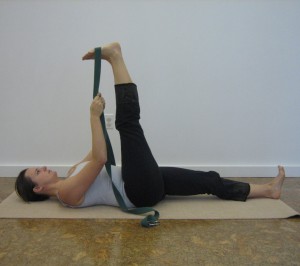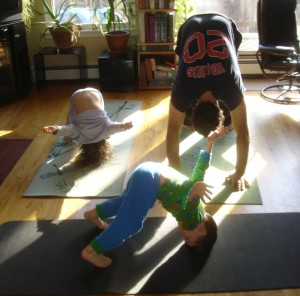On Valentine’s Day Eve (don’t tell me it’s a Hallmark holiday–when else do we get to celebrate the heart in such a gooey gaudy way?), I was rushed to the ER in my first ambulance ride after experiencing the most frightening episode of heart palpitations. This was coupled with difficulty breathing, dizziness, chest pressure, and the certain feeling of doom. Ah, sounds like love, you might say. Is my heart trying to tell me something? I’ve barely recovered from the pains of heartbreak! 🙂 I begin to think about the “heart” it takes to be a person who guides others in healing. I begin to think about the use of yoga in my clinical practice.
I began introducing yoga into my work with children way back in 2001 when I was a direct care worker with emotionally-disturbed children in a therapeutic day school/residential program. This was before I had any clinical training, and had myself only been practicing for a year or so. These kids taught me the fun and joy of exploring what the body can do. They reminded me of the silliness of the whole thing, this body that bends and twists, stretches and soars, bruises and heals.
The work I do today with body treatment has taken on an altogether more serious nature. My clients these days are teenagers, all girls for that matter, resilient, feisty, curious, self-conscious, smart, hilarious, and amazing girls. Most of them have endured horrific traumas in their lives, and the body is not somewhere that is pleasant or safe to exist. I recently took a workshop with Dave Emerson, RYT who owns and teaches at Black Lotus Yoga. He is the yoga consultant at The Trauma Center, a mental health agency based in JP that specializes in the assessment, treatment, training, and research of trauma. Dave led a two-day workshop in Providence with Bessel van der Kolk, reknown neuroscientist whose research into the science of the brain and its manifestations of trauma have contributed to the foundation of current trauma treatment. The main message is simple: the brain stores traumatic experiences in areas of the brain that cannot be accessed through verbal processing. They are the portions of the brain that control autonomic functioning—those unconscious processes that govern our heartbeat, our breathing. In their preliminary research, Dr. van der Kolk and Dave Emerson discovered that body treatments may be the more effective means of directly treating trauma.
I decided to take this into my own clinical practice. I have recently begun one-on-one yoga therapy with a teenaged client of mine. She is insightful, thoughtful, a “thinker” who often becomes flooded by her thoughts and emotions, and memories of the horrible traumas she has survived. In these moments, I have noticed that talking no longer helps her. She becomes overloaded, re-traumatized, tearful, and overwhelmed by the emotions brought about by memories of her past experiences. During times when she has become very emotionally overwhelmed, I have led her in a short series mat practice that involved heart-openers. She talked of physical pain in her chest. I asked her to stretch and open. Tears streamed down her face throughout the practice. How does it feel I asked. It hurts she answered. But she continued to move and stretch.
Today, we were doing our daily practice. Our space is a makeshift studio. I only have 30 minutes because if I don’t leave work precisely at 4:55 PM, I won’t make it to Healthworks in time for Barrett’s 5:30 class. I turn off the fluorescent lights, bring in my lamp, and roll out a mat. There is just enough room for one mat. I am wearing knee high boots and a skirt today (bad planning). But that doesn’t stop us from getting down to business. I lead her through yogic belly breathing in a seated position. We do some sun salutations and standing postures. I then ask her to lie on her back and hug her knees into her chest. She begins to talk about feelings, memories, concerns, worries, and I ask her to focus her attention on each sensation of her body, and to leave her mind behind. Her face instantly relaxes and I notice her attention return to her body. As she stretches out for Savasana, she says something to me that nearly floors me: You know, doing yoga makes me feel less alone. Really? I say, How? Well, she says, I usually get pretty lonely, like if I’m in my room all alone, almost like I don’t exist. But when I do yoga, it’s like I can feel myself there. I nearly fall over. Exactly! I exclaim. I can’t think of any better way to put it. A teen who has been through terrible trauma, who is terrified of loss, transitions, and abandonment, can move in a way that leaves her mind behind, and establishes and confirms her presence.
We end with Savasana, Namaste, a bow, and as she stands up she sighs “Man I feel SO much better. I was SO tense before.” Then, I am dashing out the door to drive home, change my clothes, snatch my yoga mat, scarf down a banana, find a parking spot, sprint up the stairs of Healthworks, mutter something to the woman in front of me in line : Man I need yoga just to de-stress from the stress of getting to this class on time. I nearly knock over two women trying to get my props. And then when I reach my mat—I can feel myself there.


